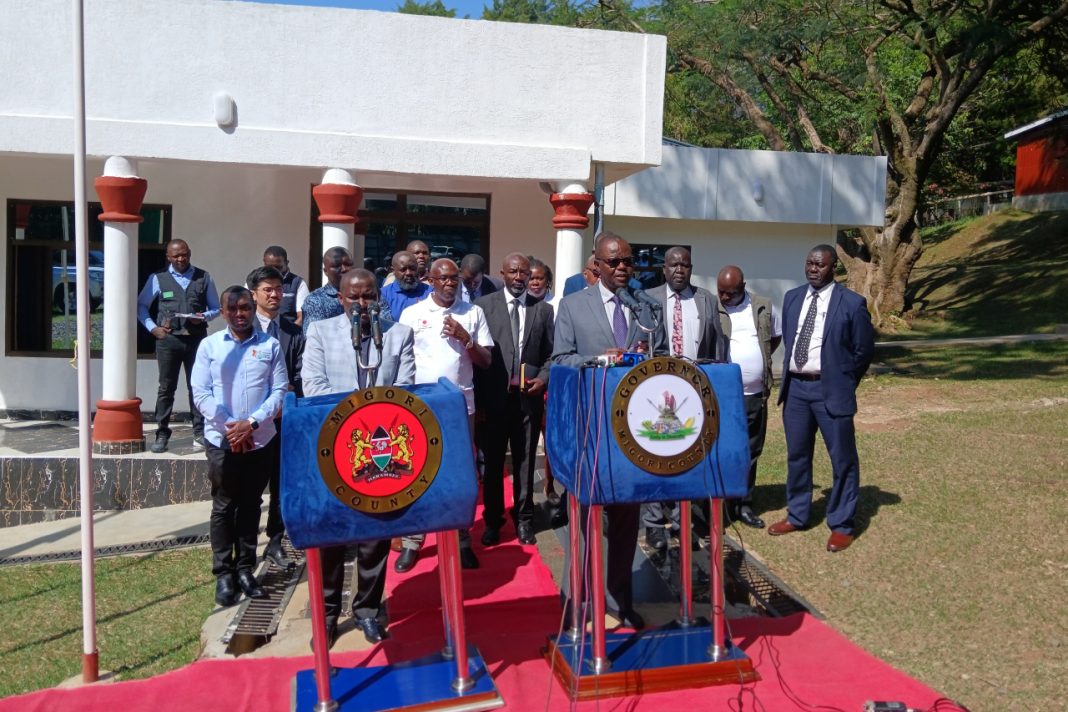By Erick Otieno
Displaced residents of the Lower Kuja Irrigation scheme in the Nyatike sub-county can now smile after the government released Sh 68 M for compensation.
Migori County Governor Dr. Ochillo Ayacko said the National Irrigation Authority has received sh 68M for the compensation of individuals displaced by the project.
The project, is supported by the National Government and International partners, is envisaged to revitalize rice production and bring significant economic growth to the region.
Ochilo who spoke in his office during a visit by key stakeholders—including Principal Secretary for Water and Irrigation, Dr. Kipronoh Rono, representatives from the Japanese Government, and the Food and Agriculture Organization (FAO) confirmed the availability of the funds.
“We are on embarking on verification process for the affected members before we can start payments. We want to be as transparent as possible,” he said.
Ochilo said once the National Lands Commission undertakes final approval, members will get their compensation.
“This is good news for the farmers, and it shows that the national government is committed to delivering on its promises.”
President William Ruto during his recent tour of Migori County and the project pledged to hasten the release of compensation fund.
The Lower Kuja Irrigation Scheme, which covers 19,000 acres, is one of the most ambitious agricultural projects in Migori County.
It has the potential to drastically boost rice production, reducing Kenya’s dependence on rice imports and positioning the county as a key contributor to national food security.
“The scheme has the potential of transforming agriculture in this region,” Ochilo said.
The governor highlighted the importance of partnerships, particularly with the Japanese Government, which has provided both technical and financial assistance through the Japan International Cooperation Agency (JICA).
In addition to boosting agricultural production, the irrigation scheme is also expected to mitigate the perennial flooding that has plagued Nyatike.
The project will channel excess water into irrigation systems, reducing the risk of flood damage while ensuring a steady water supply for both domestic and agricultural purposes.
“Our goal is to ensure that the water we receive during heavy rainfall is managed properly and turned into a resource for growth, rather than a disaster,” Ochilo stated.
Ochilo reassured local farmers that efforts were underway to secure markets for the rice they produce.
“The National Government is working with the Kenya National Trading Corporation to guarantee fair prices, preventing exploitation by middlemen,” he said.
The Lower Kuja Irrigation scheme in Nyatike constituency will both directly and indirectly benefit 197,000 persons upon completion of the project.
It is anticipated that the project will create job opportunities for more than 250,000 Kenyans, which will go a long way in addressing the soaring unemployment in the country.
Currently, the scheme hosts 5,000 farmers who have been linked with the National Cereals and Produce Board (NCPB) for subsidized fertilizer.
The project area covers six locations and 13 sub-locations in Nyatike and Karungu divisions.
Various feasibility studies in the 1980s by the Lake Basin Development Authority (LBDA) revealed the potential for irrigation within the Nyatike area with the use of water for irrigation from the two rivers of Kuja and Migori.
“ The project can improve the rice production in the country, create a sustainable supply of raw materials like straw, oil, and hull for Agro-based industries as well as contribute to the foreign exchange,” says Eng Gilbert Maluku, chair, National Irrigation Authority (NIA).
The project cost for the two phases is estimated at Sh. 2.6 Billion and 7,000 acres of rice will be cultivated in phase I and an additional 12,000 acres in phase II accounting for 19,000 acres of land for irrigation.




